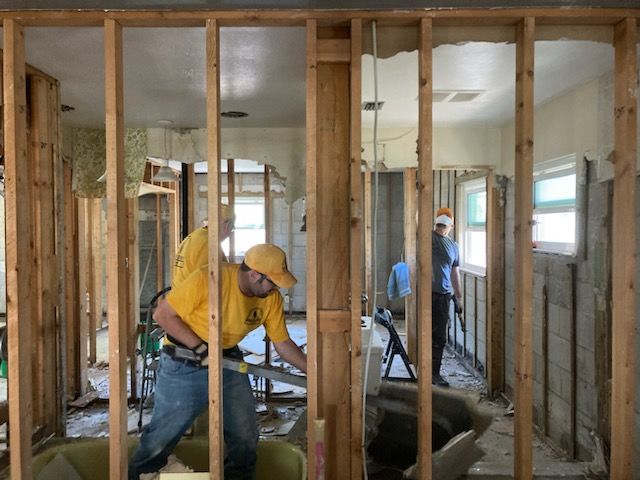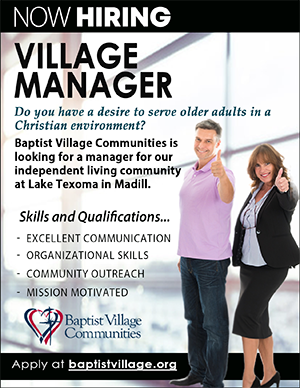This article was originally written by Scott Barkley and published to the Baptist Press. Feature image courtesy of Matt Deavers.
NEW LEXINGTON, Ohio (BP) — When it comes to Southern Baptist Disaster Relief, the physical nature of the work calls for strong bodies. However, it also calls for experience and maturity useful in ministering to those days or even hours removed from a natural disaster. And as said natural disasters don’t schedule their arrival, you need volunteers with at least some flexibility in their schedule.
In other words, the ideal volunteer is a 29-year-old with 30 years of experience whose work schedule allows him or her to deploy soon after a tornado, flood or hurricane has upended an area.
As no such volunteer exists, the next best thing is having an assortment of those who fill in the gaps on availability, experience, vitality and Christian maturity. Recent developments such as working from home and companies’ desire to contribute in some way to disaster response has helped provide flexibility for younger workers joining the field.
Matt Deavers, 28, works from home as a software engineer. His boss was supportive of a recent week long deployment with Ohio Baptist Disaster Relief to Clearwater, Fla., in the effort to clean up from Hurricane Milton.
“It was kind of surreal,” said Deavers of his first DR experience. “We cleaned out local homes and every day there were piles of debris up to 10 feet high in the street that would be hauled away and replaced by another pile.”
As someone with a desk job, he wondered how he would acclimate to the physical requirements of the work.
“God gives you strength when you need it,” he said. “Lighter work at home wears me out, but I had more energy working with others.”
He also slept better than he expected. That may have something to do with Deavers and his wife having a newborn at home, though.
John Heading, state director for Ohio Southern Baptist Disaster Relief, said a renewed effort to bring younger volunteers on board is getting results.
“It’s been a concerted effort over the last two years,” he told BP.
Training has been streamlined to where credentials can be earned online. In-person training is available too, of course, as well as on the field. Volunteers are also asked to set aside a week of their vacation leave for DR deployment.
Working as a part of Ohio Disaster Relief means on-the-field training and response takes place with DR equipment, when used. It begins under the watchful eye of a DR “blue hat.”
College student training has started with Bowling Green State University, the University of Cincinnati and Cedarville University.
“In the last two years there have been times when we go to a deployment and we’re the youngest team by a lot,” Heading said.
Georgia Baptist Disaster Relief director Dwain Carter said ages range from 18 to 93 of those serving in his state. A team of two dozen volunteers 30-45 years old from Louisiana served in Swainsboro, Ga.
The close quarters and time away from home of Disaster Relief volunteers also serves as an opportunity to learn from older Christians.
“The future for SBDR is very bright because this is a ministry that is always getting older and younger at the same time,” Carter said. “The older volunteers encourage the younger ones to join up and serve. It is a family of many thousands of people from all over the USA.”
Deavers cited highlights from his trip like working arm in arm with older volunteers to rip out drywall, scrape floors, pressure wash homes and sledgehammer apart a granite countertop for removal.
“Mudout is totally foreign to me, and I’m not that handy,” he said. “I used tools I didn’t even know the name for. But my time there strengthened my faith.
“I received an amount of advice and encouragement that was immensely helpful. As a younger guy with a bunch of people further along in the faith than me, I learned something every time they opened their mouth. The faith they have has given me a confidence to talk more about my own faith.”
Deavers had planned to use his personal vacation time to cover the trip, but his bosses decided to grant him extra paid time off instead.
Ohio Baptist Disaster Relief has been historically busy. Twelve responses came earlier this year to a record number of 70 tornadoes in the state, said Heading. Other teams went to flooding in Vermont before Hurricanes Helene and Milton struck the Southeast, making it 27 team deployments this year.
“To my knowledge, that hasn’t happened since Ohio DR started in 1986,” Heading said.
His volunteers include an older gentleman who tried to retire from his day job but was seen as too valuable by his employers to do so. They told him he could deploy with DR anytime he wanted. It also includes the younger guy who is three months sober and really wanted to invest his life in something else.
“His family thought it would be good for him,” Heading said. “He deployed for the first time recently, and I’m looking forward to hearing how it went.”
If it went bad, Heading would know by now.
With a fewer number of available volunteers, Ohio has worked from a statewide pool to form teams. Only recently have Disaster Relief teams begun forming at individual churches and associations.
That builds unity in a church while establishing a team that is on-call in the neighborhood and region.
“When they go, it’s a mission trip,” Heading said, “and Ohio DR covers the expenses.”
And there is the added benefit of helping people recover from a disaster.
“It’s not just about the physical labor, but sharing the Gospel,” he said. “Spiritual growth comes every day. You’re surrounded by Christian men and women and lean into those Christian conversations.”
For training and volunteer information, or to find more information about Oklahoma Disaster Relief, visit www.okdisasterhelp.org.






